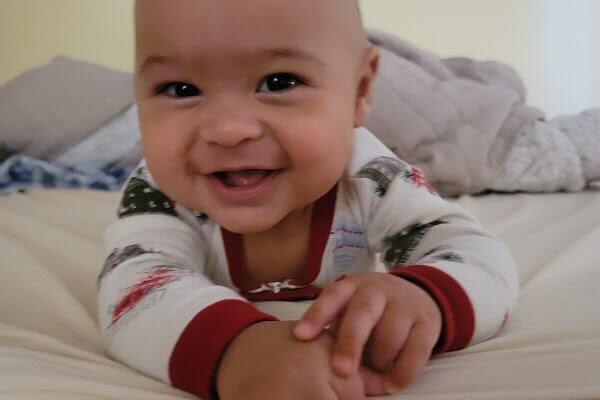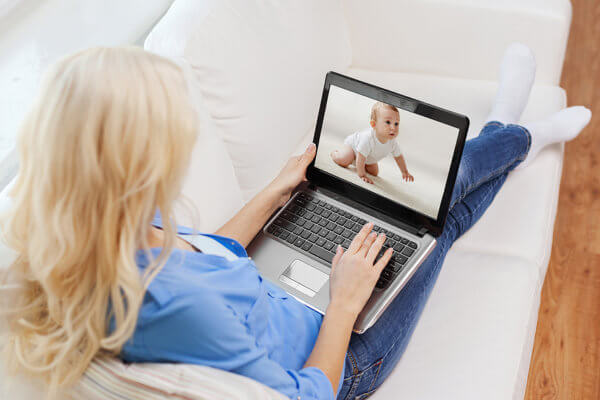Like many new parents, my husband and I were on cloud nine when we arrived home from the hospital with our newborn son, Whit. Even though it took us more than an hour to get him dressed and in his car seat, and my body ached from childbirth, we were overjoyed and awestruck by our (okay, I’ll say it!) beautiful baby boy. Sadly, by the next morning, our mood had changed. After a long night with next-to-no sleep, we were both in tears, shocked that the hospital had allowed us to leave. We knew nothing about caring for a newborn. We’d never even changed a diaper!
But don’t worry: We got up to speed quickly, and so will you. In the first few weeks, there’s a lot to learn, and like us, you’re bound to encounter some bumps in the road. But with this step-by-step baby care manual, you can eliminate much of the guesswork (and hopefully some tears!). From changing diapers to caring for the umbilical cord to clipping nails, we’ve got expert advice for keeping your little one clean, clothed and happy as a clam. Sure, you may feel intimidated at first, but before long, you’ll be a bona fide expert yourself.
Bathing
- Stick to sponge baths until your baby’s umbilical cord falls off (typically between 1 and 4 weeks) and, if relevant, his circumcision is completely healed (usually within a week).
- Before starting, gather your supplies: a mild unscented cleanser, two baby washcloths, cotton balls, two thick towels (or one towel and a waterproof pad), a diaper, diaper rash ointment or cream, and clothing.
- Place your baby on his back on a thick towel or waterproof pad next to your kitchen or bathroom sink.
- To prevent him from getting cold, make sure the room is warm, and only expose one area of his body at a time.
- Spot-clean from top to bottom, starting with his head and ending with the diaper area. Dry each part with a towel before moving on.
- Pay special attention to skin folds, especially on the neck, armpits, thighs and diaper area. Don’t forget to wash behind his ears!
- Wipe your baby’s outer ear with a warm washcloth or cotton ball. Do not attempt to clean inside the ear canal with a cotton swab.
- Use warm water and a sterile cotton ball to clean each eye, gently wiping from the nose outward.
- Until he really starts to get dirty (probably around the time he starts to crawl), bathe him no more than two to three times a week. Otherwise, you could irritate or dry out his skin.
- Once his umbilical cord has fallen off and his circumcision, if any, has healed, you can use an infant bathtub.
{pagebreak}
- Keep the umbilical cord stump as dry as possible. Don’t immerse the area in water until the stump falls off.
- Fold down the front of your baby’s diaper, or buy newborn diapers with a cut-out space for the cord, so the stump is exposed to air and doesn’t rub against the diaper.
While some doctors say to clean the area with rubbing alcohol, recent studies show that it doesn’t reduce the risk of infection or speed healing. That’s why most physicians now take a “less is more” approach. Ask your caregiver for his or her advice.
CAUTION! If your baby has a fever of 100.4 degrees F or higher, redness or swelling around the navel, or pus at the base of it—all signs of infection—call your pediatrician.
Cradle cap is essentially baby dandruff. While it may look yucky, the white or yellowish flakes shouldn’t cause your baby any discomfort. Many experts advise doing nothing and letting it run its course. Most cases disappear within four to six months.
Alternatively, you can try massaging mineral oil into your baby’s scalp to loosen the scales. Next, wash his hair with anti-dandruff shampoo, such as Head & Shoulders. Use a fine-tooth comb to remove the flakes. Repeat two to three times a week.
Before starting, be sure that all of your supplies are within reach: clean diapers, cotton balls, warm water, baby washcloths, diaper cream or ointment, and clean clothes (in case the diaper has leaked).
- Place your baby on her back on a changing table, washable pad or thick towel.
- Unfold a clean diaper and lay it to one side.
- Put another clean diaper beneath your baby in case she pees or has a bowel movement. (Fresh air on the skin can stimulate your baby to go, so beware!) If you have a boy, place a baby washcloth over his penis to prevent him from using you for target practice.
- Wipe from front to back, being careful to clean inside all the creases.
- If your baby has had a bowel movement, use the unsoiled parts of the dirty diaper to clean up as much of the mess as possible.
- Meconium (your baby’s first stool) can be really sticky, so you may have difficulty removing it. Some parents find that water and a washcloth work best, while others swear by baby oil on a cotton ball. Experiment and see what works for you.
- To prevent diaper rash, let the area dry completely before putting on diaper cream and/or a clean diaper. To speed the process, you can dry with a baby washcloth or lightly blow on the area.
- Apply diaper cream or ointment liberally on areas that look pink and rashy.
- Lift your baby’s legs and place the clean, unfolded diaper that you set aside earlier under his bottom. If you have a boy, make sure his penis is pointing down. Pull the front of the diaper between his legs and fasten.
- To contain the odor and mess, roll up the dirty diaper before disposing of it.
- >Try talking, singing or make funny faces to distract your baby as you change him.
- Don’t forget to wash your hands with soap and warm water when you’re finished!
CAUTION! While it may be months before your baby is able to roll over, keep a hand on him at all times when he’s on the changing table. Don’t leave him alone, even for a second!
{pagebreak}
When it comes to trimming your baby’s nails, you have a few options: You can use baby nail clippers; you can bite or peel them off; or you can file them with an emery board. Experiment and find what works for you! If you’re using clippers, make sure the bottom part of the clipper is underneath the nail, but that you’re not getting any skin. Getting your baby to remain still while you give her a manicure may be asking for the impossible. So do it while she’s sleeping, or ask someone else to hold her fingers steady as you cut or file. After a bath, her nails will be softer and may be easier to work with. If you accidentally nip her skin, stop any bleeding by pressing down with a sterile gauze pad.
- Do not immerse your baby in water until his circumcision is completely healed.
- While some doctors recommend applying a dab of petroleum jelly (or other ointment) and a gauze pad on the penis with each diaper change, others think it isn’t necessary. Follow your caregiver’s advice.
- Gently clean the area around the circumcision with water (and change the dressing, if any) whenever your baby has a bowel movement and the penis area gets soiled.
- You don’t need to clean it if your baby pees, since urine is sterile.
- As the circumcision heals, it may ooze and develop a whitish or yellowish appearance. These are signs that the healing process is underway, so don’t panic.
CAUTION! If your baby has a fever of 100.4 degrees F or higher, or you see redness or swelling in the circumcised area, he may have an infection. Consult your pediatrician immediately.
{pagebreak}
Taking Your Baby’s Temperature
The most accurate way to take your baby’s temperature is rectally. To do so, you’ll need a digital rectal thermometer. Old-style mercury thermometers should not be used because of the potential exposure to mercury, which is toxic.
- To start, clean the end of the thermometer with rubbing alcohol or soap and water. Rinse it with cool water. Do not rinse with hot water.
- Put a small amount of lubricant, such as petroleum jelly, on the end of the thermometer.
- Place your child’s belly down across your lap or on a firm surface, such as a changing table. Hold him by placing your palm against his lower back, just above his bottom.
- With the other hand, turn on the thermometer switch and gently slide the probe end of the thermometer 1⁄2 to 1 inch into the anal opening. Stop inserting the thermometer if it becomes difficult to insert. Never force the thermometer into the rectum.
- Hold the thermometer in place loosely with two fingers, keeping your hand cupped around your child’s bottom. Never force the thermometer or insert it too far.
- Hold in place for about one minute, until the thermometer beeps. Remove the thermometer and check the reading.
- Afterward, be sure to clean the thermometer in hot, soapy water.
Our Baby Tech Experts:
Ari Brown, M.D., coauthor of Baby 411: Clear Answers & Smart Advice for Your Baby’s First Year (Windsor Peak Press, 2005) Jennifer Shu, M.D., coauthor of Heading Home with Your Newborn (American Academy of Pediatrics, 2005) Stacy Whitman, a freelance writer based in Sun Valley, Idaho, can now change a diaper with one hand and can’t remember the last time she cried.
ORIGINALLY PUBLISHED IN NEW PARENT MAGAZINE, FALL/WINTER ‘07
An easy-to-follow guide for the proper care and maintenance of your newborn.



